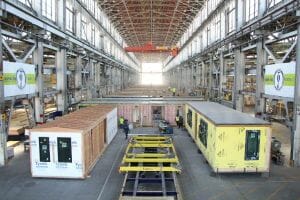Carpenter's Union Embraces Factory Built Housing to Address Labor Needs in Northern California
“We don’t have a labor shortage, we have an opportunity shortage,” said Jay Bradshaw, Director of Organizing for the Northern California Carpenters Regional Council (NCCRC). Not everyone agrees that the construction industry suffers from a labor shortage. NCCRC represents 37,500 members in 46 northern California counties and feels that labor availability is not the issue. “We have people who want to work, but with housing costs in the area, they are driving three hours to get here because they can’t afford to live in this region,” Bradshaw said.
Labor unions negotiate for higher wages and benefits for workers; higher wages, some argue, lead to higher construction and housing costs; which leads to fewer local available workers; which leads to higher housing costs. The cycle repeats continuously.
NCCRC has decided to address the issue head on – and in a manner not commonly employed by trade unions in the past. The carpenters group felt that it wasn’t in their members’ best interest to try to fight the move towards modular and offsite construction practices, as other trades have done in the past.
“We have a culture and a philosophy at the Carpenters of NorCal that when technology advances happen, we don’t try to fight it,” he says. “We want to be part of it, embrace it, support it, to stay viable in the industry, and to create more opportunities for our members. Not every organization takes that tactic”
But at the same time, the assembly line manner of construction tasks in a modular factory just didn’t neatly fit the traditional separation of trades, tasks, and wages that are common in organized labor agreements. Bradshaw continued, “Can you imagine if we built cars like this? Materials showing up in a driveway and multiple trades working on their specific part of the project. We’d end up with cars each costing about $800,000! We want to create good middle-class jobs while also trying to add to the inventory of affordable housing or everyone.”
So, NCCRC created what is called a “wall-to-wall contract” with modular factories. The idea is that the workers would be trained to do all aspects of the work, including electrical and plumbing, not just carpentry. And all the work in the factory would be covered by the carpenters’ union.
With a team of 35 full-time recruiters, NCCRC has been successful by targeting underserved populations in the construction industry such as women and minorities. But it’s not just the recruiting that makes this union successful. NCCRC trains its members at a facility near the two factories it currently represents, Factory OS and RAD Urban, each employing about 100 workers.
While the pay rate in the factory is lower than in the field, NCCRC still sees the benefit of this structure. “We’re elevating folks that don’t have opportunities and we’re going to help solve the housing crisis in Northern California,” says Bradshaw. He sees this new technology (modular) as a way to address the housing shortage by making it less costly to build. He says that when developers are able to build more, that means more construction work. Ultimately, that means more people can afford to live and work in the same area.
This article originally appeared in the Modular Advantage Magazine - Fourth Quarter 2018 released in November 2018.
More from Modular Advantage
Samantha Taylor: Leading the (Modular) Design of Tomorrow
“With modern technology and the way we’ve all embraced things like BIM, file sharing, and video conferencing since COVID, it’s easy to collaborate with companies in Austria, or Singapore, or anywhere else in the world.”
Greg DeLeon: Military Engineering to Modular Design
Greg DeLeon, a structural engineer at ISE Structural Engineers in Temecula, California, can tell you not only how large a beam needs to be to support a house, but also how much explosives you’ll need to take it down, thanks to his unique combination of professional and military experience.
To Remake North Minneapolis, Devean George Swaps Basketball for Buildings
He’s lived in Los Angeles, Dallas, and San Francisco (to name a few). He’s delivered championships with the Los Angeles Lakers and made career-defining moves with the Dallas Mavericks and the Golden State Warriors. No matter the wins, the championships, or even the seemingly impossible 3-pointers, Devean George has always returned to where it all started for him: Minneapolis.
Chelsi Tryon: Making the World a Better Place
For Chelsi Tryon, Director of Environmental, Social, and Governance (ESG) for WillScot Mobile Mini, nothing is more enjoyable than increasing the
company’s sustainability efforts while simultaneously doing her bit to save the environment.
Joshua Hart: Pushing Boundaries
Joshua Hart, P.E., vice president at Modular
Solutions, can sum up his job responsibilities in one sentence: “I do whatever needs to be done.” Hart thrives on the variety and the opportunity to be involved in every aspect of the company. And it shows! You might say Hart has come full circle.
Jamie Metzger: From Construction to Apparel and Back Again
Growing up in a blue-collar city like Edmonton, Alberta, Canada, it’s no surprise that Jamie Metzger spent some time working labor jobs on construction sites. It’s one of the most common summer jobs in the city. But that’s probably the last predictable thing about this particular story.
Victor Masso: Expanding Modular in Puerto Rico
Victor Masso joined 2 Go Storage, a company started by his grandfather and father, in 2018 to develop a modular building division in the wake of the devastation caused by Hurricane Maria in 2017. Prior to joining the company, he had worked in the industry for about four years focusing on pharmaceutical, commercial, and government projects.
Eliyah Ryals: Finding the Perfect Fit
It’s not common for people to find their perfect career fit straight out of college. It’s even less common to find it in the town you grew up in. But that’s exactly what happened when Eliyah Ryals was told about vacancies at Panel Built and made the decision to apply.
Through It All, It’s Still About the Workers
By February 2024, the number of available, unfilled construction job openings had reached an all-time high. At some point, interest rates will fall, creating another surge in demand for such workers. In short, solving the nation’s skilled worker shortage issue has never been more important.
Navigating Insurance Challenges in the Modular Construction Industry
Utilizing practical written minimum insurance and indemnity requirements, along with monitoring certificates of insurance by someone who has COI training will not yield a perfect risk transfer strategy, but the exposure will be managed much better than it likely is currently.










